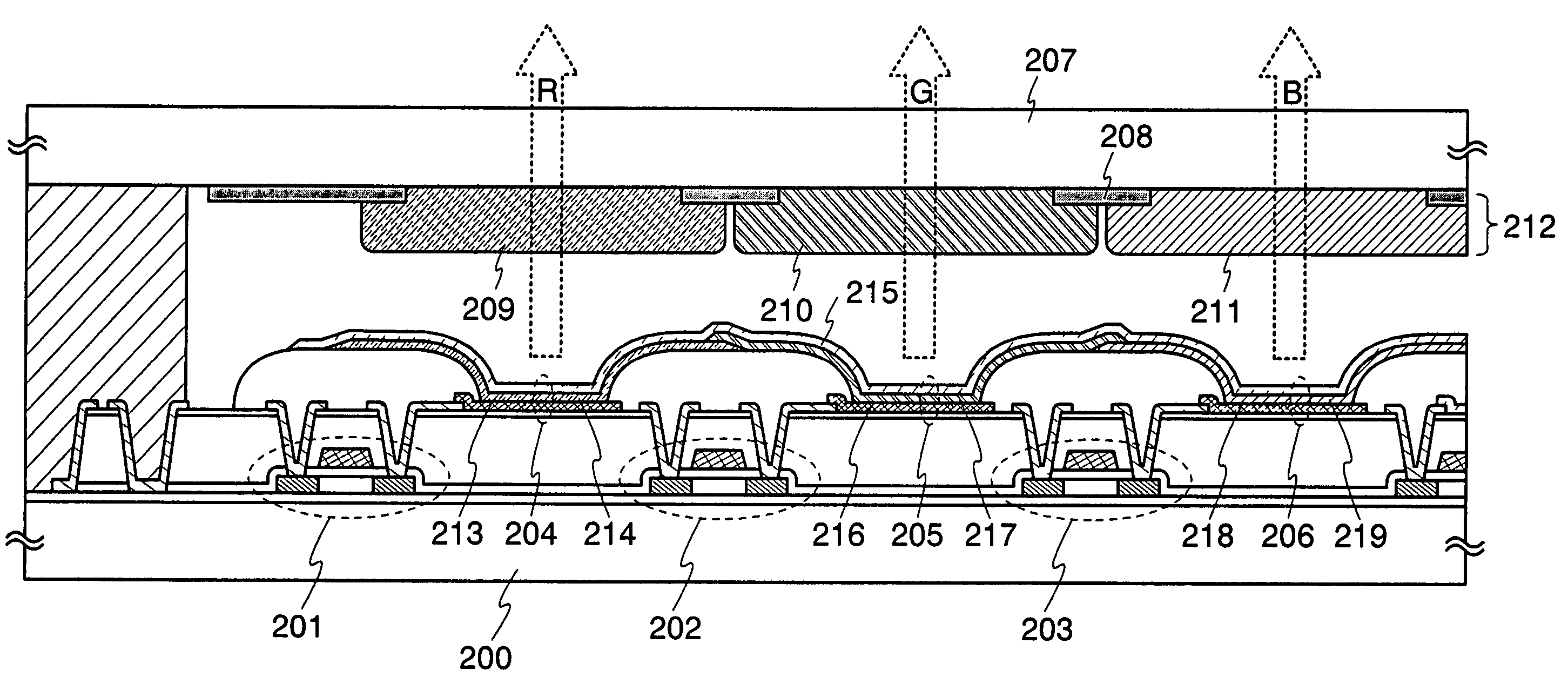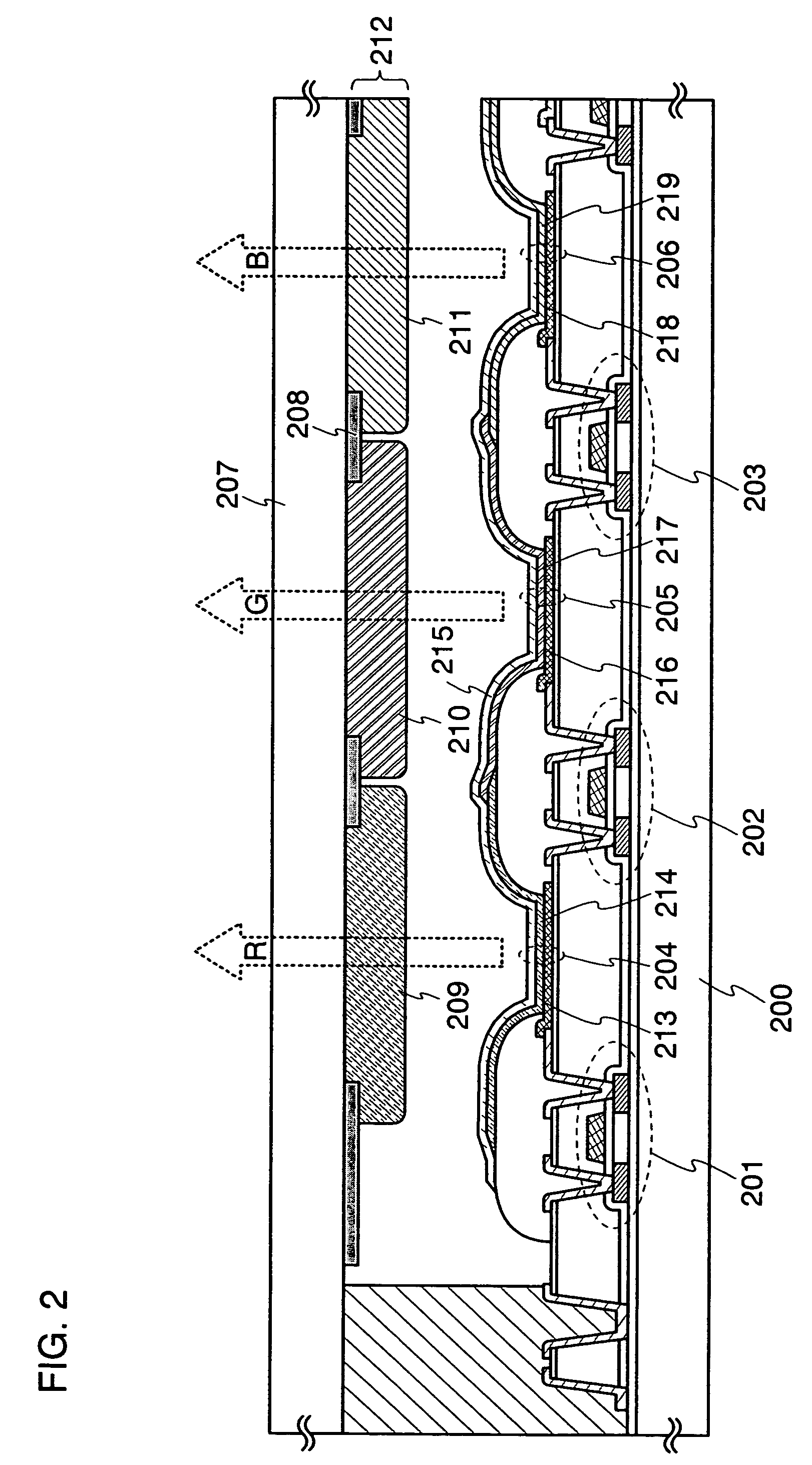Light emitting device having a layer with a metal oxide and a benzoxazole derivative
a technology of metal oxide and benzoxazole, which is applied in the direction of discharge tube/lamp details, organic semiconductor devices, discharge tubes luminescnet screens, etc., can solve the problems of reducing the transmissivity of electrodes, difficulty in enhancing light extraction efficiency sufficiently, and increasing resistivity, so as to achieve the effect of enhancing light extraction efficiency and color purity of ligh
- Summary
- Abstract
- Description
- Claims
- Application Information
AI Technical Summary
Benefits of technology
Problems solved by technology
Method used
Image
Examples
embodiment 1
[0060]In the present embodiment, a form of how to lay out a light-emitting element and a coloring layer and shielding film of a color filter will be described.
[0061]FIG. 4A shows a top view of a pixel of a light-emitting device according to the present invention. However, FIG. 4A shows a state before sealing with a covering material, where reference numerals 401 to 403 denote light-emitting elements and reference numeral 404 denotes a wiring for controlling a supply of a signal or a power supply voltage to a pixel. Further, various interlayer films and a partition are omitted in the figure. In the present embodiment, the light-emitting element 401 is presumed to be formed in a pixel corresponding a red (R), the light-emitting element 402 is presumed to be formed in a pixel corresponding a green (G), and the light-emitting element 403 is presumed to be formed in a pixel corresponding a blue (B).
[0062]FIG. 4B then shows a state where the pixels shown in FIG. 4A are encapsulated with a...
embodiment 2
[0063]In the present embodiment, the mechanism of an improvement in color purity by a color filter will be described.
[0064]FIG. 5A shows a relationship between a wavelength of light and a transmissivity with respect to a coloring layer as an example. In FIG. 5A, the wavelength range that has shorter wavelengths than 600 nm is much lower in transmissivity than the wavelength range that has longer wavelengths than 600 nm.
[0065]Further, FIG. 5B shows a spectrum in the case of light in the wavelength range corresponding to a red, which is mixed with light in the wavelength range corresponding to a green. The spectrum shown in FIG. 5B has a small shoulder from 550 nm to 600 nm in addition to a peak in the wavelength range corresponding to the red including 700 nm. The light with this spectrum is low in purity of the red, and seems to be greenish red.
[0066]Then, by transmitting the light with the spectrum shown in FIG. 5B through the coloring layer that has the characteristics shown in FI...
embodiment 3
[0068]In the present embodiment, a specific example of a light-emitting element of a light-emitting device according to the present invention will be described.
[0069]With reference to FIG. 6A, a structure of a light-emitting element from which light in the wavelength range corresponding to a blue can be obtained will be described. The light-emitting element shown in FIG. 6A has, over a substrate 600, a first electrode 601, an electroluminescent layer 602 formed on the first electrode 601, and a second electrode 603 formed on the electroluminescent layer 602. In FIG. 6A, the first electrode 601 serves as a cathode and the second electrode 603 serves as an anode.
[0070]In the present invention, a metal, an alloy, an electrically conductive compound, and a mixture of these, which have a small work function and are generally used for a cathode of a light-emitting element, can be used to form the first electrode 601. Specifically, in addition to an alkali metal such as Li or Cs, an alkali...
PUM
 Login to view more
Login to view more Abstract
Description
Claims
Application Information
 Login to view more
Login to view more - R&D Engineer
- R&D Manager
- IP Professional
- Industry Leading Data Capabilities
- Powerful AI technology
- Patent DNA Extraction
Browse by: Latest US Patents, China's latest patents, Technical Efficacy Thesaurus, Application Domain, Technology Topic.
© 2024 PatSnap. All rights reserved.Legal|Privacy policy|Modern Slavery Act Transparency Statement|Sitemap



